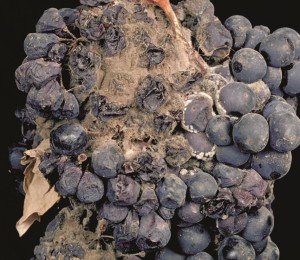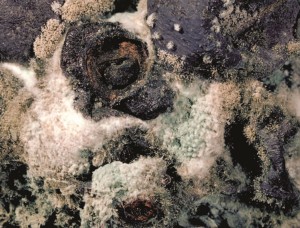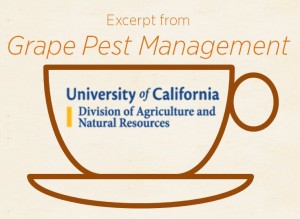 This is the second of a two-part article on bunch rot in winegrapes. Last week’s article discussed Botrytis cinerea, including symptoms on various parts of the vine (foliage, canes, berries), the disease’s life cycle, recommended management considerations (sanitation, canopy management, irrigation, chemicals), and resistance. In Part I the authors also gave an overview of the relative susceptibility to bunch rot of major grape varieties.
This is the second of a two-part article on bunch rot in winegrapes. Last week’s article discussed Botrytis cinerea, including symptoms on various parts of the vine (foliage, canes, berries), the disease’s life cycle, recommended management considerations (sanitation, canopy management, irrigation, chemicals), and resistance. In Part I the authors also gave an overview of the relative susceptibility to bunch rot of major grape varieties.
Ripening berries are susceptible to invasion by many microorganisms that frequently enter through injuries such as insect or bird feeding sites, mechanical cracks, or lesions caused by powdery mildew or esca. These organisms can cause extensive damage because their resulting rot may progress well beyond the original injury. Dark-spored fungi including Aspergillus niger, A. carbonarius, Alternaria tenuis, Cladosporium cladosporioides, C. herbarum, Rhizopus arrizhus, and Penicillium species are common, and one or more of them are usually involved in the summer bunch rot complex (fig. 13.16). However, it is the Aspergillus species that have been shown to be the first colonizers of wounded berries in the San Joaquin Valley. Botrytis cinerea, the same organism that causes Botrytis bunch rot, also frequently colonizes berries after they have been injured. The summer bunch rot complex is the more prevalent fruit rot in the warmer central and southern San Joaquin Valley, while Botrytis is the more common cause of bunch rots in the northern San Joaquin Valley and coastal production areas. Sour rot is a further development of the summer bunch rot complex, when yeasts and bacteria colonize the rot.
__________________________________________________________________________________
This excerpt from Grape Pest Management (Third Edition) was published with permission from UC ANR, and was written by Larry Bettiga and Douglas Gubler.
The Lodi Winegrape Commission and the University of California Division of Agriculture and Natural Resources (UC ANR) are partnering to provide Lodi winegrowers with the latest information about grape pest management. This is the first of several excerpts from the third edition of the Grape Pest Management book to be published here in the Coffee Shop.
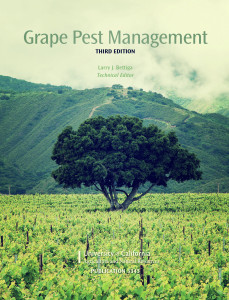
In Grape Pest Management, more than 70 research scientists, cooperative extension advisors and specialists, growers, and pest control advisors have consolidated the latest scientific studies and research into one handy reference. The result is a comprehensive, easy-to-read pest management tool.
The new edition, the first to be published in over a decade, includes several new invasive species that are now major grape pests. It also reflects an improved understanding among researchers and growers about the biology of pests. With nine expansive chapters, helpful, colorful photos throughout, here’s more of what you’ll find:
-Diagnostic techniques for identifying vineyard problems
-Detailed descriptions of more than a dozen diseases
-Comprehensive, illustrated listings of insect and mite pests
-Regional calendars of events for viticultural management
-Up-to-date strategies for vegetation management
__________________________________________________________________________________
Symptoms
Rot associated with secondary invaders can be recognized by masses of black, brown, or green spores on the surface of the berries (fig. 13.17), leakage of berry juices, and the presence of vinegar flies (Drosophila spp.) and dried fruit beetles (Carpophilus spp.). A complex of many of the fungi mentioned above along with yeasts and bacteria causes sour rot (fig. 13.18). The pungent vinegar odor associated with sour rot comes from acetic acid produced by Acetobacter. The bacteria are carried to rotting clusters by vinegar flies or driedfruit beetles that are attracted to these clusters. By the time sour rot has developed, it is often difficult to determine the primary cause.
Disease Cycle
Many of the fungi are opportunists, able to colonize only wounded berries, while others are able to initiate primary infections. Recent research has shown that both Aspergillus niger and A. carbonarius enter wounded berries and can lead to sour rot. Aspergillus infects only after veraison. Once the fungus enters the tissue, a rapid decay of the berry pulp occurs, and this is usually followed by insect visitations and colonization by other fungi and yeasts. These secondary invaders and sour rot organisms are present on most plant surfaces and on debris in the soil. They can be distributed by wind, rain, or insects and are able to begin the rot process almost as soon as the berries become wounded.
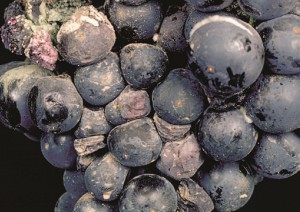
Figure 13.17 White and green spore masses produced by Penicillium and gray spores in upper left by Botrytis. Photo: J. K. Clark.
Susceptibility of grapes to secondary invasion increases as berries mature and develop sugar; berries with less than 8% sugar are relatively resistant, and their wounds often heal without rot development. In tight-clustered cultivars, berry-to-berry contact and growth pressure may cause cracks and promote berry leakage and rot. Insect damage, especially by the tortricid moths omnivorous leafroller and orange tortrix, along with bird feeding, also cause wounds that fungi can colonize.
Management
Chemical treatments are generally ineffective in preventing infection of wounds by most of the summer bunch rot complex organisms. Control strategies, therefore, must be related to the cause of the wounds. Often, controlling damage caused by birds, insects, and early-season powdery mildew infections can reduce the rot complex. Canopy management practices as discussed for Botrytis bunch rot management has also been shown to reduce the incidence of the summer bunch rot complex.
References
- Barbe, G. D., and W. B. Hewitt. 1965. The principal fungus in the summer bunch rot of grapes. Phytopathology 55:815–816.
- Bettiga, L. J., W. D. Gubler, J. J. Marois, and A. M. Bledsoe. 1989. Integrated control of Botrytis bunch rot of grape. California Agriculture 43(2): 9–11.
- Broome, J. C., J. T. English, J. J. Marois, B. A. Latorre, and J. C. Aviles. 1995. Development of an infection model for Botrytis bunch rot of grapes based on wetness duration and temperature. Phytopathology 85:97–102.
- Coley-Smith, J. R., K. Verhoeff, and W. R. Jarvis, eds. 1980. The biology of Botrytis. New York: Academic Press.
- Duncan, R. A., J. J. Stapleton, and G. M. Leavitt. 1995. Population dynamics of epiphytic mycoflora and occurrence of bunch rots of wine grapes as influenced by leaf removal. Plant Pathology 44:956–965.
- English, J. T., C. S. Thomas, J. J. Marois, and W. D. Gubler. 1989. Microclimates of grapevine canopies associated with leaf removal and control of Botrytis bunch rot. Phytopathology 79:395–401.
- Gubler, W. D., J. J. Marois, A. M.
- Bledsoe, and L. J. Bettiga. 1987. Control of Botrytis bunch rot of grape with canopy management. Plant Disease 71:599–601.
- Hewitt, W. B. 1974. Rots and bunch rots of grapes. California Agricultural Experiment Station Bulletin 868.
- Marois, J. J., A. M. Bledsoe, R. M. Bostock, and W. D. Gubler. 1987. Effect of spray adjuvants on the development of Botrytis cinerea on grape berries. Phytopathology 77:1148–1152.
- McClellan, W. D., and W. B. Hewitt. 1973. Time of infection and latency of Botrytis cinerea Pers. in Vitis vinifera L. Phytopathology 63:1151–1157.
- Thomas, C. S., J. J. Marois, and J. T. English. 1988. The effects of wind speed, temperature, and relative humidity on development of aerial mycelium and conidia of Botrytis cinerea on grape. Phytopathology 77:260–265.
- Vail, M. E., and J. J. Marois 1991. Grape cluster architecture and the susceptibility of berries to Botrytis cinerea. Phytopathology 81(2): 188–191.
- Vail, M. E., J. A. Wolpert, W. D. Gubler, and M. R. Rademacher. 1998. Effect of cluster tightness on Botrytis bunch rot in six Chardonnay clones. Plant Disease 82(1): 107–109.

